 If you’re thinking of trying a natural topical treatment for acne, then tea tree oil should undoubtedly be a top candidate.
If you’re thinking of trying a natural topical treatment for acne, then tea tree oil should undoubtedly be a top candidate.
This distillation of the leaves of a coastal Australian tree can destroy acne bacteria as simply as brushing a fly away. Better, it has been proven directly in studies, a rare topical treatment with this honour. Tea tree oil can slash inflammatory pimple counts by 46.06% after just 6 weeks (study). It backs up what the-clearing community has been saying for years. Tea tree oil won’t clear everyone, and don’t forget to dilute it, but its potential is massive.
However, there is still a dark spectre looming over tea tree oil. The spectre that half of it is fake.
Like honey, tea tree oil is one of the most commonly adulterated health products in the world. It has a tendency to fakeness even within the essential oil family, widely considered to be the wild west of natural remedies. By its very nature, tea tree oil is a fraudster’s playground of epic proportions.
Look at your shelf; the tea tree oil sitting there could be fake at this very moment. You could have applied a synthetic concoction multiple times in years gone by. Fortunately, this has an advantage too. If you’ve ever been frustrated when tea tree oil failed to clear your skin, a fake version could have been why. You might have a great opportunity to give real tea tree oil another chance.
As of 2020, adulterated tea tree oil is still going strong.
Why fake tea tree oil is unstoppable
It’s now estimated that 50% of all tea tree oil sold on Western markets is fake, and this popularity is a matter of simple economics.
For thousands of years, it was the Aboriginals’ special secret, but from 1995 to 2012, production of tea tree oil rose from 350 megatons yearly to 500 megatons (MT). In Australia, production hit an all time high of 845MT in 2015 before dropping back slightly to 700MT in 2016 due to an unforeseen drought.
Celebrity endorsements, colourful magazine articles, and good old fashioned word of mouth have helped tea tree oil to take over. Australia is king, but other producers include Kenya (20MT), South Africa (35MT), Zimbabwe (20MT) California (a tiny amount), and China (200MT).
Despite this boom though, the price is still fit for royalty. Instead of tea tree oil’s newfound abundance making it more affordable, farmers can barely keep pace with the surging demand. The price of raw tea tree oil long hovered at AUD $29 per kg before creeping up to $49 in 2008, and reverting back to normal in 2012 ($30.33)…
…and that’s where the fraudsters step in. It is far easier to simply fake your tea tree oil rather than wasting money on the raw materials.
With the popularity of essential oils, cobbling together a few imitation ingredients is a surefire road to riches. A bunch of studies have been conducted recently, and in 2013, the Australian Tea Tree Industry Association (ATTIA) collected 100 tea tree oil samples. Of the 60 bought on Austrlaian markets, just 1 was adulterated – the rest were pure tea tree oil.
However, the 40 foreign batches were another story. 25% of samples from Germany, 100% from China, 90% from the UK, and 75% from the US were impure. Most contained some tea tree oil, with 10-30% adulteration, but some were nearly 100% waste product.
2012 saw a similar experiment, where 42 samples were gathered in Europe, North America and Australia. 50% were clearly adulterated whereas 87% showed “signs” of adulteration.
That said, even Australia isn’t immune, the prestigious homeland of tea tree oil. In 2016, the Australian Competition and Consumer Commission fined Bosisto’s tea tree oil AUD $10,800 for making misleading claims, to resounding applause from traditional farmers on the coast.
In 2017, Doctor Hans Wohlmuth found that 2 out of 6 Australian tea tree oils were adulterated. For South Africa and North America, the figures were 4 out of 6 and 1 out of 5, while in the UK, 1 of 4 samples were clearly adulterated and 2 were possibly adulterated.
The fraudsters’ favourite techniques
 Like fake honey, most adulterated tea tree oil is flooding in from the vast industrial wastelands of China, though an invisible international pipeline.
Like fake honey, most adulterated tea tree oil is flooding in from the vast industrial wastelands of China, though an invisible international pipeline.
The funny thing is that when experts examine China’s total Melaleuca alternifolia (tea tree) farmland, the country should have a maximum output of 200MT. Yet every year, the country proudly exports 1200MT of products labelled as tea tree oil.
Dodgy Chinese manufacturers have two tricks up their sleeve. Before we go further, you need to under the importance of terpinen-4-ol. This monoterpene is tea tree oil’s signature compound, responsible for its famous antimicrobial properties. With acne, for example, terpinen-4-ol was shown here to inhibit both p.acnes and and s. aureus bacteria.
Therefore, the international wise old men have decreed that all bottles sold must contain at least 35% terpinen-4-ol, 14% γ-terpinene, and 6% a-terpinene, which are dubbed the ISO standards.
The key for crooked businessmen is replicate this chemical profile precisely, and the first technique is synthesising terpinen-4-ol in a laboratory. The base is frequently sabinene from pine oil, an easily convertible substance. The manufacturers carefully tinker with the proportions to make the oil indistinguishable to normal, slapping a cheerful “100% tea tree oil” label on the bottle. Natural terpinen-4-ol is created by a tree; synthetic versions are pumped out in a metallic factory. These phantom oils will never work in the same way and contain only 5 of the 113+ compounds which make tea tree oil so great.
Secondly, and most commonly, natural tea tree oil is diluted with other essential oils. This is dubbed “nature identical” tea tree oil, but it’s actually anything but.
Fraudsters are particularly fond of industrial waste from eucalyptus oil. Like melaleuca alternifolia, the eucalyptus globulus tree originates from the south-east coast of Australia. Consequently, the two cousins share numerous chemical compounds, just in wildly different proportions.
Similarly to tea tree oil, eucalyptus oil is the essence of the tree’s leaves, distilled into a liquid. However, all eucalyptus oil sold must legally be a minimum of 70% cineole. Therefore, the raw oil undergoes a process called rectification, where it is treated with alkaline in to remove the other mono- and sesquiterpenes, to push the cineole content higher. A waste liquid is left in the steel container, which is rich in other terpenes like a-pinene, terpinen-4-ol, and limonene.
It is this waste (“the tails”) which companies split with tea tree oil, and not whole eucalyptus oil. There were endless buckets of the stuff filling warehouses until one day, a lightbulb appeared over a businessmen’s head and an ingenious solution was invented.
The netherworld of the tea tree oil industry is still shrouded in darkness. Nobody knows what’s happening in its vast underbelly, but eucalyptus oil is believed to be the most popular oil for splicing and dicing. Pine oil and white camphor oil are also common. Other essential oils are more expensive and would negate the point.
Despite eucalyptus globulus originating in Australia, China now produces 90% of the world’s cineole-rich eucalyptus oil, giving them a ready made supply of terpene-rich waste.
Pine oil, meanwhile, is extracted from the cheapest part of the tree, the resin, and is used because it consists of 65% a-pinene and 8% of limonene, two more of tea tree oil’s key compounds. This adulterant is way easier to spot, because pine oil totally lacks terpinen-4-ol, but not everyone is a superintelligent criminal mastermind – some fraudsters are bumbling, low level crooks.
A new testing method…
There are doubtless different stories to every fraud. One might be a money obsessed tycoon who sits in his Jacuzzi laughing every night, while others might adulterate just 20% of the bottle, shrug their shoulders and say “good enough”, while feeling a twinge of regret.
Regardless, neither should be applied to your skin. Like with honey, criminals and testing laboratories are locked in a battle across time to outwit each other. For years, analysing the terpene content ratios was effective, before fraudsters hired some corrupt scientists and caught up. In 2017, testing labs officially introduced a new system – testing the enantiomeric ratio.
All of tea tree oil’s compounds such as limonene exist in natural D or L forms, sometimes called plus or minus forms. Countless supplements have these forms, particularly amino acids; L-lysine is vastly superior to D-lysine, while L-arginine and L-citrulline are popular with athletes. Resveratrol from red wine is similar, with cis and trans forms and the latter being best absorbed.
Scientists have now mapped out tea tree oil’s exact ratios of enantiomeric forms, to add an extra layer of defence. For example, terpinen-4-ol has a L/D ratio of 30/70. It’s one thing for fraudsters to splice in synthetic terpinen-4-ol; it’s another to change its very molecular structure.
…and how it uncovered more fraud
 In 2015, scientists tested 100 more commercial tea tree oil bottles using this system (before it was officially introduced).
In 2015, scientists tested 100 more commercial tea tree oil bottles using this system (before it was officially introduced).
They cut through the filler and travelled straight to coastal Australian plantations, with vast forests of sunny tea trees. All 57 bottles tested had the correct enantiomeric ratio of terpinen-4-ol, averaging at 31.5% L form and 68.5% D form. At most, the ratios varied by a percentage or two (study).
Then they gathered 43 tea tree oils from Asia, Europe. and North America. 20 had the correct ratios and 1 was an inch away from correct. But 50% contained just 26%-62% D-terpinen-4-ol, and 9 were below 50%. The culprit? Splicing and dicing.
Earlier in 2015, scientist gathered 103 products labelled as tea tree oil. They tested 20 natural terpenes, and found that 49% of commercial products failed to meet the standard ISO levels (study). Their terpinen-4-ol proportions were unusually low while p-cymene was weirdly high. P-cymene is the signature terpene of thyme oil (15%) second only to thymol (20-54%), but the perfect bottle of tea tree oil should only contain 0.5-8%.
Next though, they tested the D and L forms. Here’s the key detail: out of the 28 bottles that failed the enantiomeric ratio test, 7 still passed the ISO test with flying colours, the first level test that examines terpinen-4-ol or limonene levels. This proves that fraudsters are successfully getting through the system.
There are two layers of fraud. My guess is that thanks to this new test, adulterated tea tree oil will decline for 5 years, but beyond that, the fraudsters could easily catch up again. Have you ever seen James Bond films where the supervillain gets assistance from a once respected scientist who slowly turned to the dark side and started dabbling in nuclear warheads, or genetic engineering? This is precisely what’s happening with essential oil fraud. There are rogue scientists out there using their powers for evil, assisting fraudsters in the lab.
Hopefully, altering the enantiomeric ratio will prove impossible for all but the most high-tech fraudsters – it’s hard to see an out of shape hustler stirring a vat in a warehouse succeeding.
How to dodge fake tea tree oil
The good news is that wading through the great sea of fraud is pretty easy, no matter how widespread fake bottles are.
A healthy dose of common sense will show you the way. When browsing though amazon sales pages, you’ll notice that many tea tree oil bottles look weirdly similar. They use the same coloured bottle, the same shaped bottle, and even the same typeface.
Such identical brands were almost certainly cobbled together in a couple of days to make a quick buck. They probably use the exact same Chinese warehouses, the same stuffy cargo ships, and the same supplier of eucalyptus oil waste.
These brands follow a similar cycle: an explosion of popularity due to its surprising cheapness, a trickle of scathing reviews that expand into a flood, followed by eventual disappearance into thin air. That rustling sound you can hear is crooked businessmen counting their dollars.
Your solution is simply to investigate every tea tree oil brand thoroughly. In this article, we did exactly that, covering the top 10 tea tree oil brands, but if it’s a new brand, it’s not hard to complete the mission yourself. Trustworthy brands will usually present their laboratory certificate on their website, containing a completely breakdown of the terpenes. Eden’s Garden, for example, lists 42.68% terpinen-4-ol as of April 2020. Their lab report states that “this Tea Tree Oil batch sample meets the expected chemical profile for authentic essential oil of Melaleuca alternifolia. No contamination or adulteration was detected”. Always investigate their websites.
If they don’t display these certificates, then you can always email them; if they fail to respond, then something may be fishy. The worst sign is lacking a website altogether, companies that exist in a dark netherworld of chemical additives and phantom supply chains.
The words “pure Australian” mean nothing. Anyone can type those words out. You need proof. Check the bottle’s image for official certificates, where it’s an Ecocert or USDA organic label. Falsely printing these labels on a bottle is a one way ticket to a prison cell, so manufacturers won’t do it lightly.
Your second weapon is one mightier than any sophisticated lab equipment – your nose.
Have you ever noticed a funky, chemical smell in essential oils? Synthetic chemicals were almost certainly why. Dozens of amazon reviewers have noticed it too, making essential oils perhaps the single natural healthy remedy where reviews are most important.
A funky smell is the single most obvious sign of adulteration. Tea tree oil doesn’t necessarily smell great, but normally, the overpowering smell is clearly within the realm of natural, with a complexity distinct from the industrial tang of chemicals.
Aside from dodging fraudsters, remember the other important requirements for an acne-clearing tea tree oil: a glass bottle, a dark bottle, steam distilled, and the highest proportion of terpinen-4-ol you can find.
The verdict – keep your eyes peeled
In the last 24 hours, thousands of people have purchased adulterated tea tree oil. In the last 24 hours, thousands of fake bottles have been shipped into docks and transported by trucks into ready and waiting health stores.
The threat is real and that’s why you should make no compromise on the quality of your tea tree oil. If you accidentally use an adulterated tea tree oil, then it could put you off a great acne remedy for life. You don’t want to read an article, get totally excited and have your hopes and dreams deflated as hidden chemicals actually make your pimples worse.
How does tea tree oil compare? Lavender oil is also prone to fraud. Among carrier (fat-based) oils, grapeseed and olive oil are dodgy, but argan oil and tamanu are much more trustworthy.
The local villagers, in the Algerian countryside and Polynesian islands respectively, have tight control over the industries, particularly the army of gorilla workers they’ve trained to slash the nuts down. Okay, that last part was fake, but generally, giant corporations have no say in tamanu and argan oil farming. Local farmers reign supreme. In fact, farming is a misnomer; with tamanu oil it’s more like drop kicking the tree from midair so that the nut falls onto the beach.
As for tea tree oil, you should never forget the spectre of adulteration.
Thanks for reading!
When I was looking for a product for my pitted scars, I saw too many snail products, saying they had lots of vitamins, minerals and collagen, which help moisturize, lighten the skin and help improve pitted scars . Is this a myth?
It’s a huge subject, but it’s not a total myth. There’s plenty of studies, some showing antibacterial properties. I’ll have to do an article in the future. Be wary of hype though.
Thank you very much, so, what about derma rolling (a.k.a. microneedling)? Is the idea of needles pricked into the face skin a myth? They say that in doing so, the skin will be stimulated for regeneration
Funny how the Australian tea tree oil brand I have doesn’t publish its terpinol 4 content on the bottle. Just taking our trust for granted!